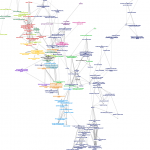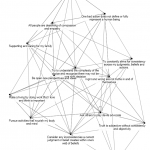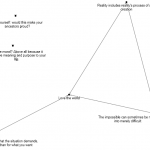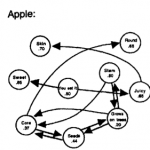Jonathan Haidt and colleagues propose that human beings have six different areas of moral concern: care, fairness, liberty, loyalty, authority, and purity. They argue that individuals and cultures differ in how they define and value these six areas, which they call “Foundations.” For instance, secular Westerners are unusual in giving very heavy weight to the first three. Within the USA, conservatives care about all six and realize that liberals are only concerned about the first three; but liberals fail to grasp conservatives’ concerns for loyalty, authority, and purity. Therefore, conservatives can predict liberals’ answers to specific questions quite accurately, but liberals do not understand conservatives–with consequences for elections and public debates.
I find these results illuminating. For example, it rings true that liberals are pretty immune to traditional concerns about purity; and even when we oppose something because it’s impure (such as completely consensual incest), we refuse to invoke concepts of purity in our reasons. At the same time, we liberals may actually have our own purity concerns. For example, I would never leave a glass bottle in the woods, and I would be at least mildly upset to see one there. I suspect the damage caused by an inert glass bottle is minimal; producing my breakfast probably hurt nature much more than a little littering. But I regard the woods as pure, and a human deposit there as a pollutant–in the moral sense.
We could call my reaction “irrational,” but that would presume that only care, fairness, and liberty are rational concerns. Haidt, who is explicitly Humean, would say that reason is and ought to be the slave of the passions. We human beings happen to have six (not just three) bases for our moral passions. Liberals are just odd; we are not distinctively rational.
The main method is factor analysis influenced by conceptual categories. Factor analysis, which is used very widely, takes people’s actual responses to surveys and looks for clusters that suggest an unobserved “factor.” For example, people may not know that they are driven by a concern for care, but their answers to a range of more concrete questions may cluster together empirically, and “care” may be a good label for this cluster. Since “Individuals are often unable to access the causes of their moral judgments,” the real causes must be unconscious and instinctive. We may not know that care is one of our Moral Foundations; that is an empirical finding.
For Haidt et al., moral factors must have two characteristics in addition to statistical clustering: 1) they must be found empirically in many cultures across the world–although it is to be expected that some cultures will miss some factors–and 2) there must be a Darwinian evolutionary explanation for why human beings would have developed these concerns. Darwinian explanations are supposed to be not mere stories that illustrate evolutionary theory but findings of biology or archaeology.
Finally, Haidt’s method is cumulative and falsifiable. He and his colleagues propose six “Foundations” right now, but they expect to add more.
A lot of assumptions are built into these methods. Arguably, the assumptions are vindicating themselves pragmatically by yielding valuable insights; but it may also be the case that the assumptions drive the methods, which determine the results. Either way, I see these premises:
1. Haidt et al. are interested in very broad categories (“Foundations”) and will even sacrifice tighter correlations if necessary to bring more survey response under broad headings. One could instead investigate the pervasive but subtle differences that arise between two people of the same cultural and ideological background, or within one person’s thinking about one moral concern. For example, I may think about care in five different ways in respect to one complex interpersonal situation.
2. Haidt et al. broaden the definition of morality to include matters–such as authority and purity–that are viewed as extra-moral by, for example, Kant. But they still name six domains as moral and exclude other psychological constructs that may explain our judgments (e.g., competition, lust, and hatred) from the list. This seems to imply a substantive theory of what counts as “moral,” despite Haidt’s repeated claims that he is a naturalist who seeks to describe, not prescribe. What if I insist that authority is not moral or that Will to Power is?
3. Haidt acknowledges that moral norms and beliefs change, but the Foundations Theory does not seem useful for explaining such changes. Haidt is a liberal who argues that liberals are rhetorically hobbled by our inability to invoke loyalty, authority, and purity. Nevertheless, the country has moved dramatically in a liberal direction on social issues that are entwined with purity and authority (e.g., gender roles). How could that happen so quickly?
4. This stream of research is concerned with the often unconscious causes of our moral judgments. It is not concerned with the way that we articulate reasons and arguments to justify our conclusions. This is because Haidt et al.–like most empirical psychologists–find that our explicit reasons are poor predictors of our concrete judgments. Our reasons are not causal.
And yet I would maintain that our reasons can be good or bad, and it matters that they are good. We are morally accountable for the quality of our reasons. It is not only important to judge and do right, but to think right. Besides, we sometimes form judgments contrary to affect because of our reasons, or we decide what to do when our instincts conflict by considering the applicable reasons, or we persuade other people by citing reasons, or we construct institutions on the basis of reasons that then constrain our behavior. Thus the ways we connect our ideas have at least some significance.
Ultimately, I think that the Foundations Theory is a form of science. It is a cumulative and falsifiable body of research, generating useful findings. Yet one can start in other places and also make progress.
I would start with the assumption that human beings are evolved animals whose brains are the product of Darwinian design. But I would also note that we human beings live and think in immensely complicated social settings that have emerged from the uncoordinated choices and actions of billions of people over thousands of years. Emergent phenomena, such as actual languages, religions, governments, and communities, are at the heart of our moral concerns. Although human beings with evolved characteristics have made these institutions, they take on lives of their own and influence us profoundly while also structuring the decisions we make. For instance, our institutions officially embody norms that we may find onerous and undesirable once applied. Although we may not be psychologically influenced by the abstract ideas that we endorse, we are politically influenced by the abstract ideas that we have written into our constitutions and catechisms. I think most of the action is at this level–in how we navigate complex and emergent systems rather than how we apply very basic biological drives.
Although people from different backgrounds hold contrasting values, there are some commonalities across time and culture. Haidt et al. and many other empirical psychologists assume that these commonalities came first and are morally fundamental, and the differences are relatively superficial. Michael Walzer summarizes this view: “Men and women everywhere begin with some common idea or principle or set of ideas and principles, which they then work up in many different ways. They start thin, as it were, and thicken with age.” “But our intuition is wrong here,” Walzer writes. “Morality is thick from the beginning, culturally integrated, fully resonant.” When we find commonalities in distant places, these are simply “reiterated features of particular thick and maximal moralities.”
[Sources: Jonathan Haidt, The Righteous Mind: Why Good People are Divided by Politics and Religion (New York: Pantheon, 2012); Jesse Graham, Brian Nosek, Jonathan Haidt, Ravi Iyer, Spassena Koleva, and Peter H.Ditto, "Mapping the Moral Domain," Journal of Personality and Social Psychology, Vol 101(2), Aug 2011, 366-385; and Michael Walzer, Thick and Thin: Moral Argument at Home and Abroad (Notre Dame: University of Notre Dame Press, 1994), p. 4, 10.]
The post Jonathan Haidt’s six foundations of morality appeared first on Peter Levine.




